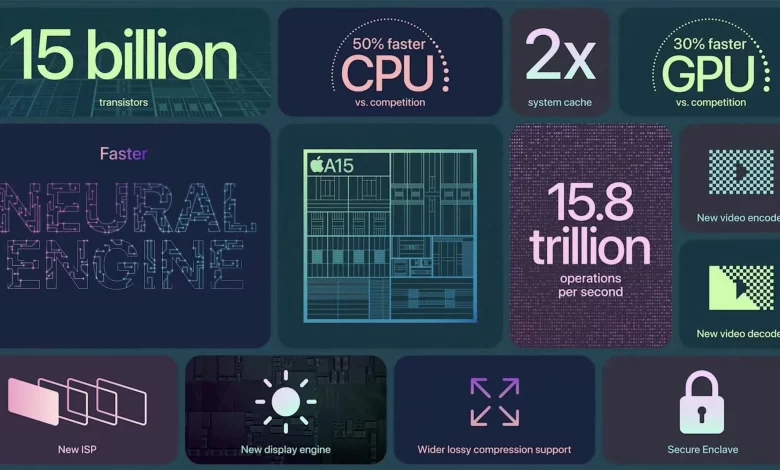A15 Bionic chipset: What Apple did not tell us at the launch event

At last week’s event, Apple tried hard to introduce the A15 Bionic chipset as the best mobile phone processor ever. This claim is quite true, but Apple has omitted some important details of this processor, details that were revealed quite by accident. Anyway, Apple has made some interesting decisions about its new silicon, and we’re going to cover that in this article.
A15 Bionic chipset
Let’s first talk about Apple’s overall image of the A15 Bionic chipset at the unveiling of the iPhone 13. The A15 chipset has 15 billion transistors and a separate neural network, which Apple calls a 16-core neural engine. This neural engine can process 15.8 million commands per second and is faster than the A14 Bionic chipset at 11 million million commands per second.
Apple has also introduced a new video signal processor for the A15 chipset, which will increase its image processing capabilities. Like the previous generation processor, the A15 is a 6-core processor with two cores called Avalanche and heavy processing, and the other four cores called Blizzard and have optimal power consumption.
Things Apple did not tell us at the event
We believe that Apple has developed the A15 Bionic chipset with TSMC’s advanced N5P architecture, which is an improved version of the 90-nanometer A14 chipset. Unfortunately, the global shortage of chipsets and silicon not only pushes up the price of Apple products like any other company, but also forces them to use parts that would not normally pass quality tests.
Diverse GPU cores
Yes, you got it right. The A15 chipset is equipped with different graphics processing cores in different devices. For example, the iPhone 13 Pro and iPhone 13 Pro Max and the iPad Mini 6 use five graphics processing cores; While the iPhone 13 Mini and iPhone 13 standard have four cores of graphics processing. We saw the same thing last year among the various MacBook models. If you think that having more or less a GPU does not make a big difference in the performance of the device, we must say that you are wrong.
The five-core version of the A15 chipset used in the iPhone 13 Pro and Pro Max has a 55% increase in graphics processing power compared to the A14 chipset. This is only 15% for the quad-core version of the A15 Bionic chip. Fortunately, the iPad Mini 6 is equipped with a 5-core version of the A15, but that’s not all, and we’ll talk more about that later. However, “it’s a graphics core” makes a huge difference in the graphics performance of devices.
As mentioned earlier, the global shortage of chipsets and silicon has changed all standards and behavior of companies – such as Apple. The company will have to use processors with a faulty graphics core to reduce costs, otherwise it will force the price of the iPhone 13 and iPhone 13 mini to rise. If prices rise, the number of buyers will decrease; Because the buyer pays for a flagship phone for a non-flagship phone and it does not feel good.
Underclocked processor
By default, the Avalanche A15 processor cores operate at 3.23 GHz, but on the iPad Mini 6, this frequency has been reduced to 2.99 GHz. If this low-frequency chipset could beat the A14 chipset, it wouldn’t matter; But the A14 chipset can beat the iPad Mini 6 in single-core tests. Of course, the A15 chipset maintains its superiority in multi-core processing even with reduced frequency, but not by much.
We do not think that Apple has a specific reason for reducing the frequency of the A15 Bionic chip in the iPad mini 6. On the issue of “temperature”, it should be said that a tablet is larger than a phone and has more space. So if the iPhone 13 can cool the A15 chipset to its core frequency, the iPad Mini 6 certainly can. The only assumption that remains is “global silicon deficiency”; The crisis that is responsible for every problem and defect today and we see its traces everywhere. Due to the lack of silicon, Apple has been forced to underclock the versions of the A15 chipset that suffer from instability at the main frequency and use it in its new tablet.
Why not use underclocked chips in iPhone 13?
Another question is: Why didn’t Apple use underclocked chips in the iPhone 13? very well; IPhones are the flagships of Apple and the brand, and the use of defective chips in them, inflicts an irreparable blow on the “iPhone” brand.
In addition, iPhone 13 buyers usually plan to use their phone for several years. Even if these users have good battery charging habits, the quality of their phone’s battery will decrease after a few years. In this case, the processor frequency is automatically reduced and the user experience of the iOS environment is slightly slowed down. Unfortunately, in some countries, such as Iran, Apple does not have an official dealership or approved repair center at all, and the user must either replace the battery himself or leave the phone in the hands of unapproved repairmen. So we more or less know why Apple has decided to overclock the A15 Bionic chipset in some devices.
Why isn’t the A15 Bionic chipset so much more powerful than the A14?
According to reports we have heard before, experienced chip engineers have left Apple. Following this incident, Apple was unable to build the chipset it expected. The A15 Bionic chipset is actually an improved version of the A14 Bionic chipset. This is probably why the old S6 chipset (Apple Watch Series 6 chipset) was used in the Apple Watch 7 Series and the new chip was not developed for it. We expect Apple to develop a new chip for 2022, but due to the lack of chipsets, the company may not have access to the advanced 3-nanometer TSMC node and will have to continue using the N5P node.
It is true that Apple has a high position in the field of technology, but there are still issues that even the Cupertino giant can not avoid. The company does its best to produce and supply the best products it can. Apple lobbied hard to get the most out of its capabilities, and even TSMC increased the price of its contract with Apple by only 3%. The company is doing its best to survive the global silicon crisis, and it has done really well. You can buy a MacBook M1 whenever you want, when popular laptops are available / non-existent in minutes. We hope that Apple will be able to improve its situation by next year and develop the A16 chipset without the issues we mentioned.
What do you think about the margins of the A15 Bionic chipset? Are these issues due to Apple’s dishonesty? Do you agree with the Cupertino giant’s ways of managing the Silicon Crisis? Be sure to share your views with us.

